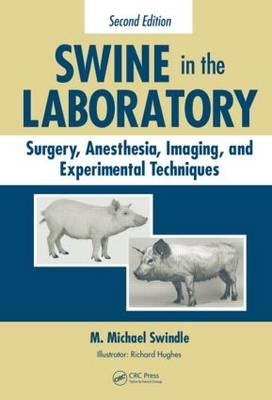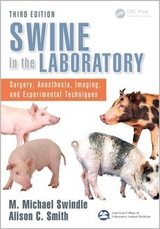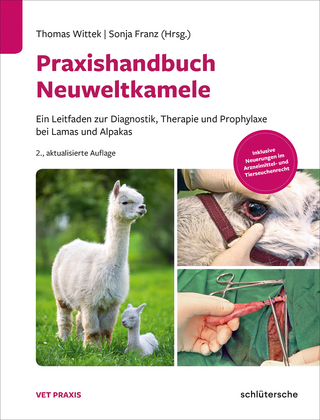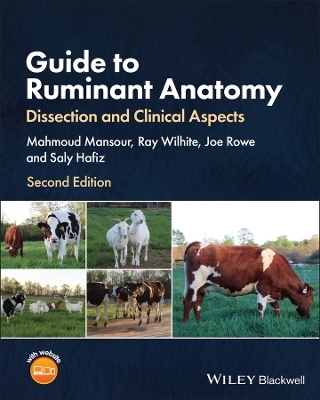
Swine in the Laboratory
Crc Press Inc (Verlag)
978-0-8493-9278-8 (ISBN)
- Titel ist leider vergriffen;
keine Neuauflage - Artikel merken
To diminish the learning curve associated with using swine as models, Swine in the Laboratory: Surgery, Anesthesia, Imaging, and Experimental Techniques, Second Edition provides practical technical information for the use of swine in biomedical research. The book focuses on models produced by surgical and other invasive procedures, supplying the basic principles for performing experiments with an organ or system of interest. New to the Second Edition * Updated sections on anesthesia and perioperative care, including practical information for more complex models * Expansion of anatomic and physiologic details * Additional detail in the endoscopy section * Chapters on toxicology and radiobiology * Chapters that include angiographic, echocardiographic, CT, MRI, and PET imaging techniques with a corresponding DVD of the images * More tables of normal values on the most commonly used minipigs and domestic breeds Beneficial for investigators, veterinarians, and technicians using swine for experimental and agricultural procedures, Swine in the Laboratory is certain to foster the appropriate, humane use of swine in biomedical research.
Medical University of South Carolina, Charleston, USA
BIOLOGY, HANDLING, HUSBANDRY, AND ANATOMY Introduction Breed Selection Biology Taxonomy and Nomenclature Reproduction Growth and Development Nutrition Hematology Behavior Husbandry Disease Prevention Restraint and Handling Administration of Medications and Injections General Anatomy Model Selection References ANESTHESIA, ANALGESIA, AND PERIOPERATIVE CARE Introduction Anesthetic Induction and Animal Prep Room Activities Endotracheal Intubation Special Perioperative Considerations Malignant Hyperthermia Paralytic Agents Postoperative Monitoring Preanesthetic Agents Injectable Anesthetic Agents Inhalant Anesthetics Cardiopulmonary Bypass (CPB) Regional Low-Flow Perfusion and Neural Protection Analgesics Commonly Recommended Protocols General Physiological Effects of Anesthetics Euthanasia References WOUND CLOSURE AND INTEGUMENT General Principles and Surgical Preparation Suture Selection for Wound Closure Skin Flaps and Grafts Wound-Healing Models References GASTROINTESTINAL PROCEDURES Surgical Anatomy General Principles of Abdominal Surgery Postoperative Care Gastronomy and Gastrostomy Techniques Pyloroplasty Enterotomy and Intestinal Fistulation Intestinal Infusion Catheter Implantation Intestinal Anastomosis Intestinal Diversion or Intestinal Bypass Colonic Anastomosis and Fistulation Total Colectomy Rectal Prolapse Intestinal and Multivisceral Transplantation Vagotomy Intraperitoneal Sepsis, Septic Shock, and Hemorrhagic Shock References LIVER AND BILIARY SYSTEM Surgical Anatomy and General Principles of Surgery Cholecystectomy Cannulation or Constriction of the Common Bile Duct Partial Hepatectomy, Liver Biopsy, and Intrahepatic Cannulation Liver Transplantation Hepatic Xenoperfusion References PANCREAS AND SPLEEN Surgical Anatomy and General Principles of Surgery Pancreatectomy, Islet Cell Ablation, and Diabetes Segmental Pancreatectomy, Pancreatic Transplant, and Islet Cell Isolation Pancreatic Duct Ablation, Cannulation, and Pancreatitis Splenectomy, Splenic Vascular Catheterization, and Splenic Transplantation References URINARY SYSTEM AND ADRENAL GLANDS General Principles of Surgery and Surgical Anatomy Nephrectomy Partial Nephrectomy and Intrarenal Surgery Renal Transplant Cystotomy and Ureteral Diversion Urinary Tract Obstruction, Reflux Nephropathy, and Hydronephrosis Perineal Urethrostomy and Urinary Diversion Preputial Diverticulum Ablation Adrenalectomy References REPRODUCTIVE SYSTEM General Principles of Surgery Castration (Orchiectomy) and Vasectomy Ovariohysterectomy, Hysterectomy, Ovariectomy, or Tubal Ligation Cesarean Section (C-Section) Fetal Surgery and Fetal Catheterization Prolapse of the Reproductive Tract Endometriosis Pelvic Adhesions Artifical Insemination and Embryo Transfer Mammectomy References CARDIOTHORACIC AND VASCULAR SURGERY/CHRONIC INTRAVASCULAR CATHETERIZATION General Principles of Cardiothoracic Surgery and Surgical Anatomy Pulmonary System Cardiovascular System Miscellaneous Thoracic Procedures HEAD AND NECK SURGERY/CENTRAL NERVOUS SYSTEM General Principles of Surgery and Surgical Anatomy Dental Procedures and Tusk Trimming Maxillofacial and Craniotomy Procedures Ocular Surgery Pharyngostomy Tubes Thyroidectomy Parathyroidectomy Hypophysectomy Spinal Cord Ischemia and Hemorrhage Stroke Models Cerebrospinal Fluid (CSF) Collection and Epidural Injection MUSCULOSKELETAL SYSTEM AND ORTHOPEDIC PROCEDURES General Principles of Surgery and Surgical Anatomy Amputation of a Digit and Hoof Trimming Tendon and Ligament Repair Tail Amputation Hernia Repair Surgical Approaches to Bones and Joints Bone Marrow Aspiration CARDIOVASCULAR CATHETERIZATION, ELECTROPHYSIOLOGY, AND IMAGING LABORATORY PROCEDURES Introduction Peripheral Vascular Access for Cardiovascular Catheters Anesthetics and Adjunct Drugs Hemodynamics Angioplasty Balloon Techniques, Intravascular Device Implantations, and Restenosis Atherosclerosis Electrophysiology and Electrocardiography (ECG) and Telemetry Pacemark Implantation and Endocardial Pacemaker Leads Conduction System Ablation Angiography Echocardiography ENDOSCOPIC, LAPAROSCOPIC, AND MINIMALLY INVASIVE SURGERY by M.M. Swindle and R.H. Hawes Introduction General Considerations Anatomic Considerations for Flexible Endoscopic Research Performing Endoscopy Endoscopic Retrograde Cholangiopancreatography Research (ERCP) Endoscopic Hemostasis (Gastrointestinal Bleeding) Colonoscopy Larynoscopy and Bronchoscopy Training in Flexible Endoscopy Laparoscopic, Celioscopic, and Thoracoscopic Surgery Postoperative Care for Laparoscopic and Endoscopic Procedures Natural Orifice Translumenal Endoscopic Surgery (NOTES) Surgical Robotics XENOTRANSPLANTATION AND TRANSGENIC TECHNOLOGIES Introduction Ethical Considerations Immunologic and Physiological Considerations Strategies for Development of Transgenic Animals Regulatory Guidelines Public Health Considerations Management and Husbandry Strategies Other Considerations TOXICOLOGY by Ove Svendsen Introduction Domestic Pigs and Minipigs Strains of Minipigs Pharmacokinetics and Metabolism Repeat Dose Toxicology Reproductive Toxicology Juvenile Studies Regulatory Acceptance Conclusions for Toxicological Models Acknowledgments RADIOBIOLOGY IMAGING TECHNIQUES: CT, MRI, AND PET SCANNING by Aage Kristian Olsen, Dora Zeidler, Kasper Pedersen, Michael Sorensen, Svend Borup Jensen, and Ole Lajord Munk Scanners Anesthesia Surgery Monitoring Scanning Procedures Technical Information for DVD Images OSSABAW ISLAND MINIATURE SWINE: CARDIOMETABOLIC SYNDROME ASSESSMENT by Michael Sturek, Mouhamad Alloosh, James Wenzel, James P. Byrd, Jason M. Edwards, Pamela G. Lloyd, Johnathan D. Tune, Keith L. March, Michael A. Miller, Eric A. Mokelke, and I. Lehr Brisbin, Jr. Introduction Characterization of the Model Summary and Conclusions Acknowledgments APPENDIX INDEX References appear at the end of each chapter.
| Erscheint lt. Verlag | 22.3.2007 |
|---|---|
| Zusatzinfo | 381 black & white illustrations, 48 black & white tables, 277 black & white halftones |
| Verlagsort | Bosa Roca |
| Sprache | englisch |
| Maße | 178 x 254 mm |
| Gewicht | 1028 g |
| Einbandart | gebunden |
| Themenwelt | Veterinärmedizin ► Großtier |
| ISBN-10 | 0-8493-9278-0 / 0849392780 |
| ISBN-13 | 978-0-8493-9278-8 / 9780849392788 |
| Zustand | Neuware |
| Informationen gemäß Produktsicherheitsverordnung (GPSR) | |
| Haben Sie eine Frage zum Produkt? |
aus dem Bereich



